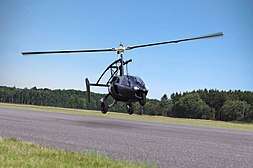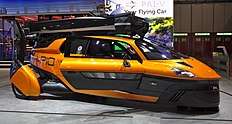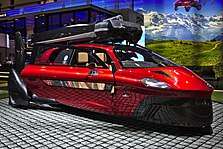PAL-V
PAL-V (Personal Air and Land Vehicle) is a Dutch company that is involved in the development of the first commercial flying car, the PAL-V Liberty. It is a compact two-person aircraft that can travel on public roads.[1]
 | |
| Industry | Aircraft manufacturer |
|---|---|
| Founded | 2001 |
| Headquarters | , |
| Products | PAL-V Liberty |
| Website | www |
PAL-V Liberty
| PAL-V Liberty | |
|---|---|
| Role | Flying Car, Roadable aircraft |
| Manufacturer | PAL-V |
| Designer | C. Klok (exterior design) |
| First flight | March 2012 |
| Status | In test |
| Number built | 1 |

The PAL-V Liberty is a combination of a car and an autogiro, or gyroplane. Therefore, both a driver's license and an autogiro pilot's license are required to operate the PAL-V Liberty.
The gyroplane principle convinced them for a number of good reasons. "The gyroplane principle not only provides us with a safe and easy-to-operate flying car but it also enables us to make it compact and within existing regulations, which is the most important factor to build a useable flying car," said Mike Stekelenburg, Chief Engineer at PAL-V.[2] You need to get your PPL (private pilot license) type rated on a gyroplane to fly the PAL-V Liberty. This includes theoretical and practical training. The practical training takes between 30 and 40 hours before a person can take the exam.
On the ground, the propeller and rotor are stopped and power is diverted to the wheels, allowing it to travel as a three-wheeled car. This will be easier and safer for take-off and landing. In addition, it also has a high center of gravity to make it stable in the air by ensuring the propeller to push through the center of gravity. These were the best choices but gave also a great challenge in the development of the flying car. In 2005 a technology provided a solution for the high center of gravity. A solution by the Carver vehicle, also produced by a Dutch company. This Dynamic Curve Stabilizer System ensured the road safety of the 'roadable gyroplane'.[3]
In 2009 PAL-V tested the tilting system with Prototype X1 on the road. After the successful test, PAL-V started to build Prototype X2, also known as the PAL-V ONE. PAL-V made its first flight with the PAL-V ONE in 2012.[4][5] At that time, the company was seeking funds to develop the type for production. Estimated unit price in 2012 was around €300,000.[6][7] By proving this concept, PAL-V started the design of its first commercial flying car model, based on the proven technologies.[3]

In February 2017, PAL-V started its marketing campaign with the public launch of the PAL-V Liberty and announced that they have started selling the first commercial flying car. The production model was first publicly shown at the Geneva Motor Show in Switzerland on 6 March 2018. CEO Robert Dingemanse expects that all certification requirements will be completed in 2021.[8]
PAL-V has 2 different editions, the Liberty Sport and the Liberty Pioneer. The Sport edition is the basis model. The Pioneer edition is the limited edition model. This model will be delivered prior to any other PAL-V. It also includes all the options that are available. Prices will be different to which country you want to order it. If you want to order a PAL-V Liberty from Europe then the Sport edition will start from €300,000 and the Pioneer edition will be €500,000.[9]


After delivering 90 Pioneer Editions, PAL-V will start shipping the Sport Edition. The first delivery is expected to be in 2021.[3]
On, 9 th March, 2020 the company , VP, international business development, Carlo Maasbommel , signed an MOU ( Memorandum of Understanding ) , with the state of Gujrat , to set up manufacturing and export unit in Gujrat , India . The company aims to export PAL-V from India to US , Netherlands , UK etc by 2021. [10]
Specifications
Technical specifications
- Capacity: 2 persons
- Mass empty: 664 kg
- Maximum Take-Off Weight (MTOW): 910 kg
- Maximum baggage load: 20 kg
- Fuel type: Euro 95, Euro 98, E10
- Fuel capacity: 100 l
Drive mode
- Max speed: 170 km/h
- Top speed acceleration (0-100 km/h): <9 seconds
- Engine power: 100 hp
- Dimensions, L×W×H: 4 × 2 × 1,7m
- Range: 1300 km
Flight mode
- Economic cruise speed: 140 km/h
- Max speed: 180 km/h
- Engine power: 200 hp
- Dimensions, L×W×H: 6,1 × 2 × 3,2 m
- Rotor diameter: 10,75 m
- Maximum altitude: 3500 m
- Take-off distance: 180 m
- Landing roll distance: 30 m
- Range: 400-500 km
References
- PAL-V website
- PAL-V. "PAL-V unveils the limited edition flying car".
- "The PAL-V Story". PAL-V.
- "Dutchmen invent plausible flying car" TopGear, 3 April 2012. Retrieved 4 April 2012. Quote: "PAL-V features the same Dynamic Vehicle Control system used on the Carver ONE"
- Quick, Darren. "PAL-V flying car makes successful first test flight" GizMag, 2 April 2012. Retrieved 4 April 2012.
- "Will sales of flying car take off?". BBC News. Retrieved 2019-08-16.
- Flying car makes maiden voyage (57 pictures) Washington Post, 3 April 2012. Retrieved 4 April 2012.
- PAL-V. "PAL-V world's first flying car production model comes to life".
- PAL-V. "Purchase your PAL-V".
- "Dutch Firm To Build Flying Car In India". CarandBike. Retrieved 2020-03-10.